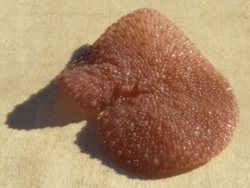Sea pansy
| Sea pansy | |
|---|---|
 | |
| Scientific classification | |
| Kingdom: | Animalia |
| Phylum: | Cnidaria |
| Class: | Anthozoa |
| Subclass: | Octocorallia |
| Order: | Pennatulacea |
| Family: | Renillidae |
| Genus: | Renilla |
| Species: | R. reniformis |
| Binomial name | |
| Renilla reniformis | |
The sea pansy is a colonial cnidarian native to warm continental shelf waters of the Western Hemisphere.[1] It is frequently found washed ashore on northeast Florida beaches following northeasterly winds or rough surf conditions. It also can often be found living intertidally completely buried in the sand. Its predator is the striped sea slug, Armina tigrina.
The sea pansy is a collection of polyps with different forms and functions. A single, giant polyp up to two inches in diameter forms the anchoring stem (peduncle). This peduncle can be distended to better anchor the colony in the substrate. The pansy-like body bears many small, anemone-like feeding polyps. A cluster of tentacleless polyps form an outlet valve that releases water to deflate the colony. If the colony is on a sand bar at low tide, it usually deflates and becomes covered with a thin film of silty sand. Small white dots between the feeding polyps are polyps that act as pumps to expand the deflated colony. The feeding polyps secrete a sticky mucus to trap tiny organisms suspended in the water. The colony’s rigidity and purple color come from calcium carbonate spicules throughout the polyps tissues.
The sea pansy is strikingly bioluminescent when disturbed because of the interplay between a luciferase (Renilla-luciferin 2-monooxygenase) and green fluorescent protein (GFP). Both molecules have recently become extremely important in biology.[2]
References
- ↑ "Sea Pansy (Renilla reniformis)". Encyclopedia of Life. Retrieved 10 June 2014.
- ↑ Ruppert, Edward; Fox, Richard (1988). Seashore Animals of the Southeast. University of South Carolina Press.
External links
- Discussion of green fluorescent protein in the sea pansy
- http://150.176.130.202/species/seapansy.htm Whitney laboratory for Marine Bioscience
- Bill Frank, Jacksonville, Florida